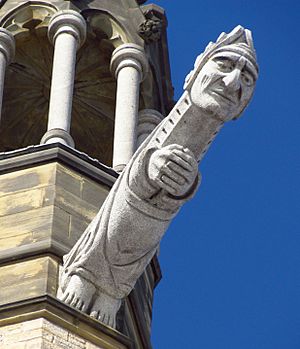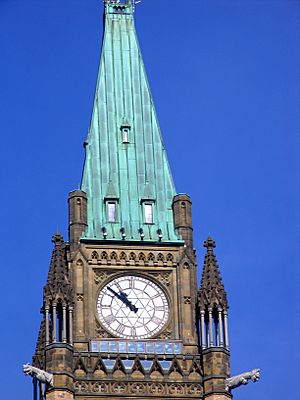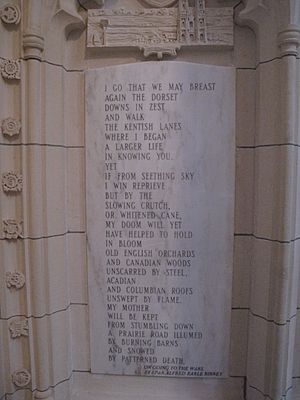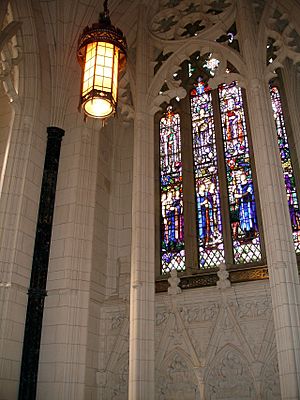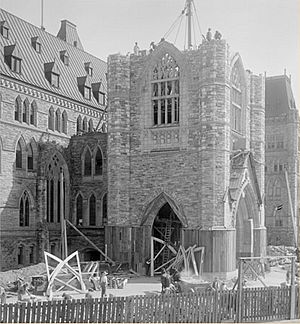Peace Tower facts for kids
Quick facts for kids Peace Tower |
|
|---|---|
|
Tour de la Paix
|
|
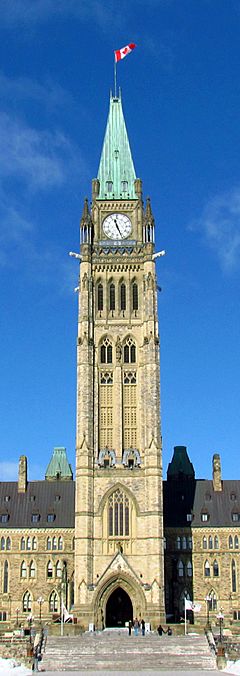
Main facade in 2012
|
|
| General information | |
| Type | Tower |
| Architectural style | Perpendicular Gothic |
| Location | Ottawa, Ontario, Canada |
| Coordinates | 45°25′29″N 75°41′59″W / 45.4248°N 75.6996°W |
| Completed | 1920 |
| Height | 98 m (322 ft) |
| Technical details | |
| Lifts/elevators | 1 (previously 2) |
| Design and construction | |
| Architect | Jean Omer Marchand and John A. Pearson |
The Peace Tower (French: Tour de la Paix) is a tall bell and clock tower. It stands right in the middle of the Centre Block of the Canadian parliament buildings in Ottawa, Ontario. This tower replaced the old Victoria Tower after a big fire in 1916. That fire destroyed most of the Centre Block. Only the Library of Parliament survived.
The Peace Tower is a very important Canadian symbol. It used to be shown on the Canadian twenty-dollar bill.
Contents
What is the Peace Tower Like?
The Peace Tower was designed by Jean Omer Marchand and John A. Pearson. It is a type of bell tower called a campanile. The tower is 92.2 meters (302 feet 6 inches) tall. Its design follows the Victorian High Gothic style. This style matches the rest of the parliament buildings.
The tower's walls are made of Nepean sandstone. Its roof is made of reinforced concrete covered with copper.
At the bottom of the tower, there is a covered entrance called a porte-cochère. It has four pointed arches. The north arch is the main entrance to the Centre Block. The south arch has carvings of the Royal Arms of Canada.
Near the top of the tower are four large clock faces. Each clock face is 4.8 meters (16 feet) wide. There is one clock face on each side of the tower. The clock's parts were made by the Verdin Company. They are set by the National Research Council Time Signal.
One level below the clocks is an observation deck. This deck goes all the way around the tower. For many years, this was the highest place you could visit in Ottawa. The Peace Tower was the tallest building in the city. Later, rules about building height changed. Other buildings became taller than the Peace Tower.
At each of the tower's four corners, at the observation deck level, are four large stone carvings. These carvings are called gargoyles. They are 2.5 meters (8 feet 4 inches) long. They are made of grey granite from Quebec.
The Flagpole's Meaning
The tower's flagpole is very important. It acts as the main flagpole for the whole country. Special rules decide which flags can fly there. For example, the flag is flown at half-mast for national mourning. The flag of the King or Queen, or the Governor General, flies when they are visiting Parliament Hill.
How to Get Up the Tower
In 1981, a new special elevator was put in. It goes up at a 10-degree angle at first. Then it goes straight up for the rest of the way. The elevator car stays level the whole time. Before this new elevator, visitors had to take one elevator, then stairs, then a second elevator to reach the observation deck.
The Memorial Chamber
The Peace Tower was designed to be more than just a beautiful building. Architect John A. Pearson wanted it to be a memorial to Canadians. It honors those who died during the First World War.
Inside the tower is the Memorial Chamber. It is a special room, 7.3 meters by 7.3 meters (24 feet by 24 feet). It is located right above the main entrance. The room has stained glass windows and other features. These show Canada's history in wars. For example, the floor has brass plates made from old shell casings from battlefields. These plates list Canada's main battles in the First World War.
John Pearson himself collected stones from European battlefields. These stones are used in the floors and walls of the room. Pearson called the room a "sacred grove."
Books of Remembrance
The stone walls were first meant to have the names of all Canadians who died in the First World War. But there wasn't enough space for all 66,000 names. So, they decided to place Books of Remembrance there instead. These books list all Canadian soldiers, airmen, and sailors who died serving their country. This includes those who died in the War of 1812, the Nile Expedition, the Boer War, the First World War, the Second World War, and the Korean War.
The books are shown in glass cases on seven altars around the room. A page in each book is turned every day at 11 a.m. This way, every name can be seen by visitors at least once a year.
Poems and Writings
The Memorial Chamber also has carved marble plaques. These plaques tell about Canada's military history. Five marble plaques show famous writings. Two plaques have the poem "In Flanders Fields" by Canadian doctor Lieutenant-Colonel John McCrae. One plaque has a part from French-Canadian author Gabrielle Roy's book Bonheur d'occasion (The Tin Flute). A verse from the Bible, Psalm 139:8-10, is on another plaque. A fifth plaque has the poem "On Going To The Wars" by Canadian writer Earle Birney.
Sculptures in the Chamber
Many parts of the room were made from stone from European battlefields. For example, limestone came from the United Kingdom. Black marble and St. Anne marble came from Belgium. Stone for the walls and ceiling came from France.
These materials were carved into 700 different pieces. Many artists and sculptors worked on them. They were led by Ira Lake. The goal was to tell the full story of Canada's part in the First World War. It also honors military groups going back to the 17th century.
Around the entrance archway, you can see The Sword of Victory. This is a carving above the opening. There are also two stone lions by Pearson and other sculptors. Each lion holds a shield. The left shield shows the Dragon of Destruction and the date 1914. The right shield shows the Dove of Peace and the date 1918.
Inside the archway, there is a sculpture called The Tunnellers' Friends. It shows animals that helped in the war. These include reindeer, mules, pigeons, horses, dogs, canaries, and mice. Below them, it says: THE TUNNELLERS’ FRIENDS, THE HUMBLE BEASTS THAT SERVED AND DIED.
Around another arch, you can see carved animals and insects. These include beetles, spiders, lizards, butterflies, rats, hares, bats, birds, frogs, and bees. John Pearson said these represent Canada's wildlife.
The walls of the Memorial Chamber have 17 special sections called niches. Each niche has a marble slab under a gothic arch. They are decorated with badges and symbols of military groups. These include Canada's old militia regiments and other forces. The marble panels used to describe battles from 1914 to 1918. In 1982, they were changed. Now they show Canadian military actions from the Fenian Raids to the Korean War. They also include parts from the Bible, poems, and other writings.
Stained Glass Windows
John Pearson chose Frank S.J. Hollister to design the Memorial Chamber's stained glass windows. Hollister's designs were approved in 1925. Each of the three large windows is 7 meters (23 feet) tall and 3.5 meters (11 feet 6 inches) wide. They show symbolic figures and symbols. These include the Royal Arms of Canada, the arms of each province, and the arms of the United Kingdom.
- The Call to Arms Window
This window shows four symbolic figures: Victory, Labour, Progress, and Science. Below them are four panels. One panel shows people uniting for war. Another shows a man calling "To Arms." A third panel shows nurses of battle. The fourth panel shows men and horses gathering for war.
- The Spirit of Sacrifice Window
This is the south window. The first panel shows the archangel Michael. He holds a trumpet, calling to battle. It also shows a woman with children, symbolizing the sacrifices of families. The second panel has famous quotes. It also shows St. George slaying a dragon. The third panel shows Lady Justice with scales and a sword. Below her is a figure of Canada, looking sadly at the Book of Remembrance. The fourth panel shows Joan of Arc.
- The Dawn of Peace Window
This window shows four figures at the top: Victory of Peace, Prosperity, Progress, and Plenty. In the lower part, a crowd of people are gathered in peace. They are led by figures representing Industry, Agriculture, Honour, and Motherhood. At the bottom of some panels are quotes from the Bible.
The Carillon Bells
The Peace Tower has a 53-bell carillon. This set of bells was created to remember the end of World War I in 1918. It was first played on July 1, 1927. This was the 60th anniversary of Canada becoming a country.
The smallest bell weighs 4.5 kilograms (10 pounds). The largest bell, called the bourdon, weighs 10,160 kilograms (10 long tons). All the bells were made in England. A musician called the Dominion Carillonneur plays the bells. They play regular concerts and mark important events like state funerals and Remembrance Day. Each bell stays still. An inside hammer hits it to make a sound. The carillon is played like a piano. The musician changes the sound by how they press the keys.
History of the Peace Tower
The Peace Tower was planned right after the parliament buildings burned down in 1916. Its creation also happened at the end of the First World War.
On July 1, 1917, Prime Minister Robert Borden dedicated the spot where the tower would stand. He said the tower would be a "memorial to the debt of our forefathers and to the valour of those Canadians who, in the Great War, fought for the liberties of Canada."
The first stone of the Peace Tower was laid by Prince Edward (who later became King Edward VIII). This happened on September 1, 1919, during his visit to Canada. The tower was finished in 1922.
In the summer of 1925, a small ceremony was held in the Memorial Chamber. Important people like Governor General of Canada Viscount Byng of Vimy and Prime Minister William Lyon Mackenzie King laid stones for the columns.
Prince Edward returned to Ottawa in 1927. He dedicated the altar in the Memorial Chamber. He also officially started the Dominion Carillon. The first time the bells were played that day, people across Canada heard it on the first ever coast-to-coast radio broadcast. Once finished, the Peace Tower was the tallest building in Ottawa and all of Canada.
In 1994, the Peace Tower was covered for two years. This was for a project to fix the stone and stop water damage. In 2006, the clock stopped working for the first time in 28 years. It stopped at 7:28 for about a day.


